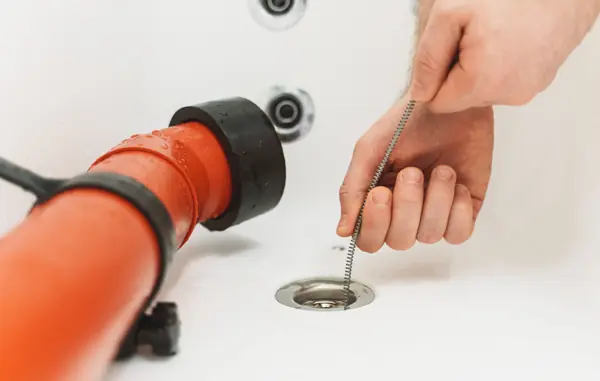Spring soil temperatures provide ideal circumstances for pipe leaks. After winter, the ground changes and settles, causing pipes to move or misalign. Older or weak-connected underground pipes are stressed by soil expansion and contraction with changing temperatures. This movement can cause imperceptible cracks, fractures, or minor leaks, causing concealed water damage or low water pressure.
Spring rain and soil movements can worsen pipe troubles. Thawing ground can damage or leak old or worn pipelines. Spring rain and groundwater saturation raise underground pipe pressure, increasing leak risk. Have pipes inspected this season to avoid costly water damage and maintain your plumbing system.
How does spring weather affect underground pipe movement?
Spring weather can significantly affect underground pipe movement due to the changes in soil temperature and moisture levels. Here’s how:
- Soil Thawing and Expansion: As temperatures warm up in the spring, the frozen ground thaws. This thawing process causes the soil to shift and expand, which can put pressure on underground pipes. Suppose pipes are not properly secured or made of materials susceptible to movement. This expansion can cause pipes to shift, bend, or even crack, leading to potential leaks or breakages.
- Moisture and Water Saturation: Spring often brings increased rainfall, which can saturate the soil around underground pipes. When the soil becomes overly wet, it can become more unstable, causing it to shift or settle unevenly. This movement can lead to misalignment or stress on pipes, especially if they are old or have weak points.
- Soil Compaction and Settling: As spring rains penetrate the soil, they can compact or erode the ground, shifting the position of pipes. Over time, the shifting or settling of soil can create gaps or cause pipes to become misaligned, leading to leaks or reduced water flow.
- Freeze/Thaw Cycles: In regions with fluctuating spring temperatures, repeated freeze-thaw cycles can exacerbate the movement of underground pipes. The constant expansion and contraction of the soil can add stress to pipes, potentially causing them to crack or dislodge.
Spring weather, with its thawing soil, increased moisture, and fluctuating temperatures, can lead to the movement of underground pipes, resulting in leaks, misalignment, or damage to the plumbing system. Regular inspections during this season can help prevent serious plumbing issues.
What role does soil temperature play in pipe leakage?
Soil temperature plays a significant role in pipe leakage, particularly when temperatures fluctuate, or soil changes can stress underground pipes. Here’s how soil temperature influences pipe integrity:
- Expansion and Contraction: When soil temperature rises in the spring, the ground thaws and expands. This expansion can exert pressure on pipes, causing them to shift, crack, or break if they are not properly anchored or made of materials that can withstand such movement. Conversely, in colder months, soil contracts as it freezes, which can also pressure pipes, leading to cracks or leaks over time.
- Frost and Thaw Cycles: In regions with fluctuating temperatures, the freeze-thaw cycle of soil can exacerbate pipe movement. When the soil freezes, it expands, creating pressure on pipes buried in the ground. As temperatures rise in the spring, the soil thaws, and the pipes may shift or settle unevenly, leading to misalignment or joint stress, which can cause leaks.
- Increased Soil Moisture: When soil temperature increases during the spring, rain or snowmelt may absorb more moisture. Saturated soil can become unstable and shift, creating additional stress on pipes. Water movement through the soil can also cause pipes to loosen or shift, leading to potential leakage.
- Soil Compaction: Warmer soil temperatures can affect soil compaction around underground pipes. If the soil becomes too loose due to changes in temperature and moisture, pipes may become misaligned or sink, increasing the likelihood of leaks.
Soil temperature influences the physical movement and pressure exerted on underground pipes, particularly during seasonal temperature changes. Expansion, contraction, and moisture fluctuations can cause pipes to shift or crack, leading to leaks and potential damage. Proper pipe installation and regular inspections are important to prevent these issues.
Can seasonal changes increase the risk of plumbing leaks?
Yes, seasonal changes can significantly increase the risk of plumbing leaks due to fluctuations in temperature, soil conditions, and moisture levels. Here’s how these changes affect plumbing systems:
- Freeze-Thaw Cycles: In colder months, the water inside pipes can freeze, causing the pipes to expand. The ice thaws as temperatures warm in the spring, but the pipes may not return to their original shape, potentially causing cracks or leaks. Repeated freeze-thaw cycles can weaken pipes over time, making them more prone to failure.
- Soil Movement: Seasonal temperature changes can cause the soil surrounding underground pipes to expand and contract. In winter, frozen soil expands, putting pressure on pipes, while thawing in the spring can lead to soil settling or shifting. This movement can misalign or damage pipes, resulting in leaks, especially if they are not properly secured or are made of materials prone to cracking.
- Increased Water Flow: Thawing snow and rain can saturate the soil during spring, leading to higher groundwater levels. This increased moisture can pressure pipes, particularly if they are old or not adequately protected. The added water flow can also create conditions conducive to pipe corrosion, leading to leaks over time.
- Expansion and Contraction: Pipes made of materials like metal or plastic can expand and contract with temperature changes. These materials may stress as the weather shifts between hot and cold, leading to small leaks, especially at joints and fittings. Over time, this constant movement can compromise the integrity of the plumbing system.
Seasonal changes—especially the freeze-thaw cycle, soil movement, and increased moisture—can increase the risk of plumbing leaks. Regular inspections, especially before and after major weather shifts, can help identify and prevent potential issues caused by these environmental changes.
Why do more plumbing leaks occur during the spring months?
More plumbing leaks occur during the spring months due to factors related to temperature changes, increased moisture, and soil movement. Here’s why spring is particularly prone to plumbing issues:
- Freeze-Thaw Cycles: During the winter, pipes can freeze, causing them to expand. When temperatures rise in the spring, the ice inside the pipes thaws, but the pipes may not fully return to their original shape, causing cracks or leaks. This freeze-thaw cycle can weaken pipes, especially older ones, and increase the likelihood of leaks.
- Soil Movement: Spring is often when the ground thaws after a cold winter, which can lead to soil expansion and contraction. As the soil settles, it can shift, putting pressure on underground pipes. This movement can misalign or stress the pipes, leading to leaks, especially if the cold has already weakened the pipes.
- Increased Water Flow: The spring thaw brings a significant amount of melting snow and rain, increasing the water flow in the ground. This added moisture can pressure plumbing systems, particularly those already vulnerable or made of materials that may deteriorate over time. The excess water can also create conditions where pipes are more likely to corrode, leading to leaks.
- Corrosion and Wear: The combination of moisture, fluctuating temperatures, and older plumbing systems makes spring an ideal time for corrosion, especially for metal pipes. As pipes corrode, they become weaker and more prone to leaks, especially as they experience additional strain during the spring months.
The spring season’s freeze-thaw cycles, soil movement, increased moisture, and pressure on plumbing systems create the perfect storm for leaks. Regular inspections before and during the spring months can help catch these issues early and prevent costly damage.
Prevent Spring Leaks: Protect Your Pipes Today!
As temperatures rise and the soil thaws, the risk of plumbing issues increases. The freeze-thaw cycles and soil shifts can pressure your pipes, leading to cracks and leaks. Our expert team at Hi-Desert Plumbing specializes in identifying and repairing plumbing issues caused by seasonal changes.
Don’t wait for a leak to disrupt your home—contact us today for a comprehensive inspection and timely repairs. Ensure your pipes are secure and ready for the warmer months with our trusted plumbing services!





